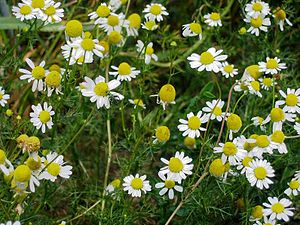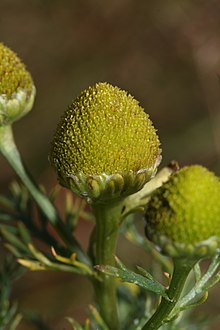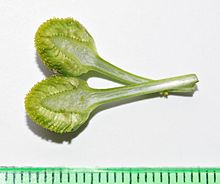Camomiles
| Camomiles | ||||||||||||
|---|---|---|---|---|---|---|---|---|---|---|---|---|

Real chamomile ( Matricaria chamomilla ) |
||||||||||||
| Systematics | ||||||||||||
|
||||||||||||
| Scientific name | ||||||||||||
| Matricaria | ||||||||||||
| L. |
The camomile ( Matricaria ) constitute a genus within the family of Compositae (Asteraceae). The seven or so species are mainly found in Europe , Asia Minor , temperate regions of Asia , North Africa and North America . Some species are in many areas of the world, and on the southern hemisphere , invasive plants .
description




Appearance and leaves
Matricaria species grow as annual herbaceous plants and, depending on the species and location, usually reach heights of 10 to 25 (1 to 80) centimeters. They form tap roots . The parts of the plant are often aromatic. Per specimen one to more than ten mostly independently upright or ascending, rarely lying, bald to sparsely hairy stems are formed, which can be branched.
At the beginning, basal leaves are formed, which wither quickly, and later alternate leaves are distributed on the stem. The leaves are at most short stalked. The leaf blades are spatulate to oblong or egg-shaped in outline, rarely simple, usually two to three pinnate or lobed with numerous linear sections. The base of the spread can encompass the stem or be eyed. The leaf sections are linear and often curved and spiky at the top. The edge of the leaf section is completely and more or less bent back. The leaf surfaces are glabrous to sparsely hairy.
Inflorescences, flowers and fruits
The stalked, basket-shaped inflorescences are individually or in open, schirmtraubigen total inflorescences together. In the kneecap-shaped shell (involucre) with a diameter of 4 to 14 millimeters, there are 25 to 50 bracts in several, usually three or four (two to five) rows. The durable, almost identical, membranous bracts are elongated, egg-shaped to spatulate or linear-spatulate and have dry-skinned edges and dry-skinned (translucent = hyline) rounded to blunt upper ends. There are no leaves of chaff on the conical or oval-shaped and hollow basket bottom .
The flower heads always contain 120 to over 750 tubular flowers and usually 10 to 22 ray-flowers (ray-flowers are absent in Matricaria discoidea ). The ray-flowers, marginal flowers = ray-flowers are tongue-shaped, purely feminine, fertile and white with an elliptical-egg-shaped tongue. The disk flowers = tubular flowers are all hermaphroditic, fertile, tubular and often somewhat asymmetrical. The yellow to greenish-yellow or yellowish-green corollas of the tubular flowers have a more or less widened corolla tube and a pitcher to bell-shaped corolla throat which ends in four or five corolla lobes spread out.
On the achenes there are the halved corollas, which then sometimes have sessile, golden glands. The reverse-conical achenes are compressed laterally and mostly asymmetrical with oblique upper ends. The achenes have three to usually five white longitudinal ribs on the inside and bare, smooth surfaces in between. The outside is convex. The achenes become wet and slimy. The pappus is a small crown or it is missing. Auricles are sometimes present on the achenes that develop from the ray-flowers.
Sets of chromosomes
The basic chromosome number is x = 9.
Systematics and distribution
The genus Matricaria was established by Carl von Linné . The botanical genus name Matricaria comes from the Latin word matrix for uterus, since the real chamomile ( Matricaria chamomilla ) was used as an ancient remedy for gynecological diseases . A synonym for Matricaria L. nom. cons. is Chamomilla S.F. Gray . The genus Matricaria belongs to the subtribe Matricariinae from the tribe Anthemideae in the subfamily Asteroideae within the family Asteraceae .
There are around seven species of Matricaria (selection):
- Matricaria aurea (Loefl.) Sch.Bip. (Syn .: Chamomilla aurea (Loefl.) Gay ex Cosson & Kralik ): It iswidespreadin southern Europe , North Africa , western Asia , in the Caucasus region, in Central Asia and on the Indian subcontinent.
- Real chamomile ( Matricaria chamomilla L. , Syn .: Matricaria recutita L. , Chamomilla recutita (L.) Rauschert , Matricaria courrantiana DC. ): It is widespread in Eurasia and North Africa and a neophyte in many other countries around the world .
- Radiationless chamomile or radiant chamomile ( Matricaria discoidea DC. , Syn .: Matricaria suaveolens (Pursh) Buchenau ; Chamomilla suaveolens (Pursh) Rydb. ): It is widespread in East Asia and North America and is a neophyte in many countries around the world (including Europe) .
- Matricaria occidentalis Greene (Syn .: Chamomilla occidentalis (Greene) Rydb. ): It thrives at altitudes from 0 to 2400 meters only in the US states of California and Oregon .
No longer to the genus Matricaria , but to the genus Tripleurospermum , for example:
- Matricaria caucasica (Willd.) Poir. → Tripleurospermum caucasicum (Willd.) Hayek
- Odorless chamomile (Syn .: Matricaria inodora L. , Matricaria perforata Mérat ) → Tripleurospermum inodorum (L.) Sch.Bip.
- Matricaria maritima L. → Common beach chamomile ( Tripleurospermum maritimum (L.) WDJKoch )
swell
- Luc Brouillet: Matricaria Linnaeus. - Same text online as the printed work , In: Flora of North America Editorial Committee (Ed.): Flora of North America North of Mexico . Volume 19: Magnoliophyta: Asteridae, part 6: Asteraceae, part 1 (Mutisieae – Anthemideae). Oxford University Press, New York / Oxford a. a. 2006, ISBN 0-19-530563-9 , pp. 450 (English). . (Sections Description and Systematics)
- QON Kay: Chamomilla SFGray . In: Thomas Gaskell Tutin et al .: Flora Europaea . Volume 4, 1976, p. 167. Cambridge University Press. ISBN 0-521-08717-1 .
- Wendy L. Applequist: A reassessment of the nomenclature of Matricaria L. and Tripleurospermum Sch. Gdp. (Asteraceae). In: Taxon , Volume 51, Issue 4, 2002, pp. 757-761. abstract.
Individual evidence
- ↑ a b c d e f g h i j k l m n o p q Luc Brouillet: Matricaria Linnaeus. - Same text online as the printed work , In: Flora of North America Editorial Committee (Ed.): Flora of North America North of Mexico . Volume 19: Magnoliophyta: Asteridae, part 6: Asteraceae, part 1 (Mutisieae – Anthemideae). Oxford University Press, New York / Oxford a. a. 2006, ISBN 0-19-530563-9 , pp. 450 (English). .
- ↑ a b c d e f g h Q.ON Kay: Matricaria L. , pages 165–166 In: Thomas Gaskell Tutin et al .: Flora Europaea . Volume 4, 1976. Cambridge University Press. ISBN 0-521-08717-1 .
- ↑ a b c d e Matricaria in the Germplasm Resources Information Network (GRIN), USDA , ARS , National Genetic Resources Program. National Germplasm Resources Laboratory, Beltsville, Maryland. Retrieved April 23, 2014.
- ↑ Enter the taxon in the search mask for The Global Compositae Checklist .